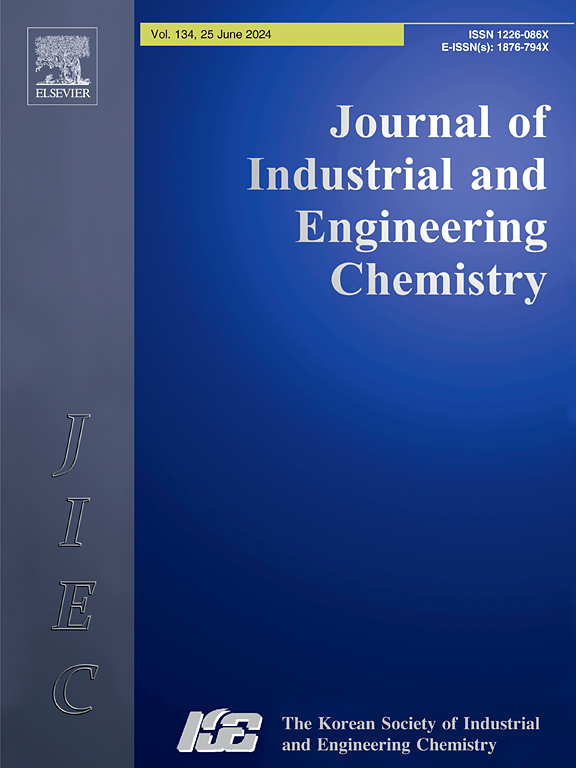IF 5.9
3区 工程技术
Q1 CHEMISTRY, MULTIDISCIPLINARY
Journal of Industrial and Engineering Chemistry
Pub Date : 2024-12-01
DOI:10.1016/j.jiec.2024.11.055
引用次数: 0
摘要
本研究采用乙二醇-草酸深共晶体系(DES)对油茶果壳(COS)进行脱木素处理。研究了处理温度和时间对木质素去除率、木质素纯度和产量的影响。在处理温度为 90 °C 和处理时间为 6 h 的条件下,残渣率、木质素去除率和产率分别为 42.33 %、67.79 % 和 45.84 %。通过傅立叶变换红外光谱(FT-IR)和二维核磁共振光谱(2D HSQC NMR)确定了木质素的结构,光谱结果表明 COS 木质素主要由愈创木基(G)单元组成,其次是丁香基(S)单元。根据热重分析法(TG)和差示扫描量热法(DSC)对木质素进行了热分析,确定木质素的玻璃化转变温度在 90 至 130 °C 之间。研究结果表明,乙二醇-草酸-DES 系统可用于促进 COS 的高效脱木素。本文章由计算机程序翻译,如有差异,请以英文原文为准。

Efficient fractionation of lignin from Camellia oleifera shell by acidic deep eutectic solvent under mild conditions
In this study, ethylene glycol-oxalic acid deep eutectic system (DES) was used for delignification of Camellia oleifera shell (COS). The effects of treatment temperature and time on lignin removal rate, lignin purity and yield were investigated. At the treatment temperature and treatment time of 90 °C and 6 h, the residue rate, lignin removal rate and yield values of 42.33 %, 67.79 % and 45.84 %, respectively. The structure of lignin was ascertained by performing Fourier transform infrared spectroscopy (FT-IR) and two-dimensional nuclear magnetic resonance spectroscopy (2D HSQC NMR), the spectra of which indicated that COS lignin mainly comprises guaiacyl (G) units, followed by syringyl (S) units. Thermal analysis of lignin was conducted based on thermogravimetric analysis (TG) and differential scanning calorimetry (DSC), and the glass transition temperature of lignin was determined to be between 90 and 130 °C. The results in this study indicated that ethylene glycol-oxalic DES system can be used to facilitate the efficient delignification of COS.
求助全文
通过发布文献求助,成功后即可免费获取论文全文。
去求助
来源期刊
CiteScore
10.40
自引率
6.60%
发文量
639
审稿时长
29 days
期刊介绍:
Journal of Industrial and Engineering Chemistry is published monthly in English by the Korean Society of Industrial and Engineering Chemistry. JIEC brings together multidisciplinary interests in one journal and is to disseminate information on all aspects of research and development in industrial and engineering chemistry. Contributions in the form of research articles, short communications, notes and reviews are considered for publication. The editors welcome original contributions that have not been and are not to be published elsewhere. Instruction to authors and a manuscript submissions form are printed at the end of each issue. Bulk reprints of individual articles can be ordered. This publication is partially supported by Korea Research Foundation and the Korean Federation of Science and Technology Societies.

 求助内容:
求助内容: 应助结果提醒方式:
应助结果提醒方式:


